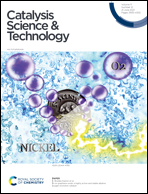Superior catalytic activity of α-Ni(OH)2 for urea electrolysis†
Abstract
Ni(OH)2 shows great promise as an electrocatalyst for the urea oxidation reaction (UOR), which can be employed in energy conversion devices such as direct urea fuel cells. The stacking of nickel hydroxide layers with different chemistries results in diverse crystal structures of nickel hydroxide. Compared to the β phase, α-Ni(OH)2 allows more than one electron transfer during redox transition, which is beneficial to energy conversion applications. This study reveals that the synthesized α-Ni(OH)2 electrocatalyst exhibits higher current responses (increased by 138% at 1.5 V vs. RHE), a lower slope in the Tafel plot (89 vs. 121 mV dec−1), and an improved reaction rate constant (increased by 290%) for the UOR in comparison with its nickel hydroxide counterpart (i.e., β-Ni(OH)2). Moreover, quantitative analyses based on the normalized current responses with respect to the double-layer electrochemical surface area of the nickel hydroxide electrodes indicate the higher intrinsic UOR catalytic activity of the α-Ni(OH)2 catalyst. More importantly, the α-Ni(OH)2 catalyst exhibits superior stability toward urea electrolysis in a 20 000 s test without noticeable degradation of the catalyst.



 Please wait while we load your content...
Please wait while we load your content...